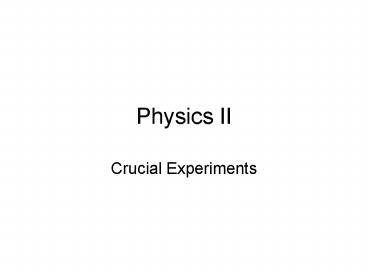Physics II - PowerPoint PPT Presentation
1 / 25
Title:
Physics II
Description:
Matter and e-m share another feature: they can exhibit both particle ... Cavity radiation photo. Note brighter area at hole (near center) Kirchhoff and spectra ... – PowerPoint PPT presentation
Number of Views:14
Avg rating:3.0/5.0
Title: Physics II
1
Physics II
- Crucial Experiments
2
Synopsis
3
Resumé/Prospectus
- We have spent some time carefully establishing
the atomic structure of matter and the structure
of the atom itself. - Not only do we deal with matter constantly we
also deal with electromagnetic energy - We now try to learn what e-m radiation is like
4
The Big Differences
- As we delve into this study the big difference
between our new perspective and that of our
previous studies will be that not only does
matter come in discrete lumps, but so does light,
energy, momentum, angular momentum - Matter and e-m share another feature they can
exhibit both particle-like and wave-like
properties
5
Old Quantum Theory
- Blackbody Radiation (1900)
- Photoelectric Effect (1905)
- Compton Effect (1923)
- Bohr Atom (1913)
6
Thermal Radiation
- Thermal Radiation
- Based on knowledge that all bodies at non-zero
temperatures radiate and absorb e-m radiation - Radiate at all wavelengths is the supposition
- But at different wavelengths intensities vary
- In ordinary materials nature of surface matters
7
Kirchhoffs Contribution
- Hypothesized that the intensity distribution
function of radiation depended only on
temperature and wavelength (not on the material
but only on the radiation.) - Important detail
- Detecting devices cannot measure intensity at a
single frequency but rather in a narrow box or
channel of frequencies - I? f(?,T) (J/m2)/(m.s) or (W/m2) / m
8
Absorption/emission
- Emission coefficient
- ?? (W/m2)/m
- Energy emitted per unit time in tiny channel
- Absorption coefficient
- ?? (unitless)
- Fraction of e-m energy absorbed per unit time in
tiny channel
9
Kirchhoffs radiation law
- Clearly, at equilibrium, in an enclosure,the
whole of radiation absorbed must equal that
emitted else temperature would rise or fall. - Kirchhoff tightened this to hold for each narrow
channel - Energy radiated by walls in channel energy
absorbed in that channel - ??I? ??
- hypothetical radiation with unit absorption
coefficient at all frequencies is called
blackbody radiation and also cavity radiation
10
Cavity radiation photo
- Note brighter area at hole (near center)
11
Kirchhoff and spectra
- Hot gases emit a discrete spectra characteristic
of that material - Cool gases viewed against white light produce a
characteristic absorption spectrum - Frequencies of emission and absorption spectra
coincide for like elements - Hot solids emit continuous radiation
- Atomic interactions in solid blur the
characteristic frequencies - Cavity radiation independent of material
12
Other features of cavity radiation
- Stefan-Boltzmann Law
- Power per unit area emitted is proportional to
the fourth power of the absolute temperature - P/A ?T4
- Derivation uses fact that radiation exerts
pressure - Wien displacement law
- The wavelength of the radiation with peak
intensity is inversely proportional to the
absolute temperature - ?pT constant
- Uses Doppler shift produced by a moving mirror
13
Planck Curves
- Max Planck (1900)
- Considered a metallic cavity enclosure containing
radiation in equilibrium with the radiating
oscillators that compose the wall - Tried to curve-fit the experimental curves of
the spectral distribution emerging from the
cavity - The physics of the time predicted very different
curves
14
Classical predictions
- While the experimental curves were near zero at
very low and very high frequencies, (high and low
wavelengths) classical physics predicted
divergences at short wavelengths (high
frequencies) - The Ultraviolet Catastrophe
15
Plancks way out
- Here is a good reference. It is at
- http//spiff.rit.edu/classes/phys314/lectures/plan
ck/planck.html - The basic idea was that the interaction of the
radiation and oscillators of walls was quantized,
the size of the quantum depending on the
frequency of the light - Discontinuity appeared in the interaction
16
Planck Curve simulators
- http//www.usask.ca/chemistry/courses/243/links/BB
R/BBR.html - http//csep10.phys.utk.edu/guidry/java/blackbody/b
lackbody.html
17
Einstein went further
- In the work for which he received the 1921 Nobel
prize, Einstein, in 1905, explained the odd
results of the photoelectric effect experiments
by generalizing Plancks notion to suggest that
light (e-m radiation) itself was made up of
quantized particles (localized lumps) of energy,
later called photons by G.N. Lewis - http//hyperphysics.phy-astr.gsu.edu/hbase/mod1.ht
mlc5
18
Photoeffect Java Applets
- http//www.walter-fendt.de/ph11e/photoeffect.htm
19
The resulting arithmetic
- Conservation of energy as photon strikes a single
electron in the metal (and photon disappears) and
electrons are emitted to form a measurable
current. - hf KEmax ?
- KEmax eVS
- h 6.626 0693(11) x 10-34 J s
- h 4.135 667 43(35) x 10-15 eV s
20
Compton Effect
- The photoelectric effect uses visible and
ultraviolet light to impinge on electrons bound
with the same order of magnitude energy - Arthur Holly Compton (inventor of the speed bump)
used X-rays - X-rays have much higher energy than electrons in
the target - Electrons are free
21
The main idea
- Compton (and Debye) independently derived the
equation for the difference in wavelengths
between the incident X-ray and the secondary
scattered X-ray by assuming a collision between
BB like entities -- X-Ray photon and electron. - Used ideas of special relativity to do so.
- Conservation of energy
- Conservation of momentum
22
Java Applets
- http//www.walter-fendt.de/ph11e/photoeffect.htm
- http//www.launc.tased.edu.au/online/sciences/phys
ics/compton.html
23
Experimental Arrangement
- Schematic representation of experiment
24
Compton effect data
- Compton Scattering
25
Compton wavelength
- ?C h/(mc)
- Some values (CODATA 2002)
- ?C 2.426 310 238(16) x 10-12 m (electron)
- ?C 1.319 590 9067(88) x 10-15 m (neutron)
- ?C 1.321 409 8555(88) x 10-15 m (proton)
- ?C 0.697 72(11) x 10-15 m (tau)













![L 34 Modern Physics [1] PowerPoint PPT Presentation](https://s3.amazonaws.com/images.powershow.com/7125701.th0.jpg?_=20150905079)

![L 33 Modern Physics [1] PowerPoint PPT Presentation](https://s3.amazonaws.com/images.powershow.com/7602675.th0.jpg?_=201602121011)















